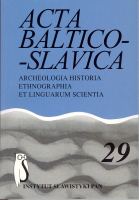Wahania l//ł w wydawnictwach kowieńskich publikowanych w języku polskim w Republice Litewskiej (1919-1940)
Variations of l//ł in the publications which were published in the Polish language in the Lithuanian Republic (1919-1940)
Author(s): Jolanta MędelskaSubject(s): Language and Literature Studies
Published by: Instytut Slawistyki Polskiej Akademii Nauk
Keywords: Kovno/Kaunas interwar Polish language; written language; lateral consonants; Polish-Lithuanian relations; Polish-Lithuanian language contact
Summary/Abstract: In the present paper the author makes an attempt to find the causes of l/ł shift encountered in Polish press published in Kaunas in the interwar period. In the texts analysed the frequency of occurrence of the l/ł shift is very high (347 tokens). Moreover, the frequency of curious l is much higher than the number of occurrences of ł. Interestingly, similar frequency and proportion of shifts can be observed in other Kaunas written sources. The explanation of this phenomenon can be twofold: the l/ł shift can reflect the actual pronunciation used in Kaunas in the interwar period or it can be a graphic misinterpretation of the actual pronunciation. Of a number of possible phonetic reasons responsible for this shift, there are several taken into consideration in the present paper: (1) ł is a front-lingual consonant and it is typical of both East Slavic languages as well as Lithuanian; (2) there is a tendency of using front ł instead of a hard all-Poland l (as in ałe or tyłko); (3) the influence of Lithuanian in which the consonants ł and l not only display differences in softness but also a partially different distribution when compared with their Polish equivalents (e.g. ł does not occur in the following contexts: before front vowels, before soft consonants, as a final sound); (4) hypercorrectness; (5) lexical influence of l/ł equivalents occurring in Belorussian and russian; (6) the preservation of traditional pronunciation (e.g. Baltyk); (7) analogical alignments (e.g. pomylka due to pomylić, szkołny due to szkoła). The second, highly probable, source of l//ł shift mentioned above is a graphic misinterpretation of l//ł pronunciation, which might occur under the influence of Lithuanian spelling rules. Namely, in the Lithuanian alphabet there is one graphic symbol, i.e. l, used to encode both l’ as well as ł, and the phonetic realization of the letter l is dependent on the grapheme which follows it.
Journal: Acta Baltico Slavica
- Issue Year: 2005
- Issue No: 29
- Page Range: 87-104
- Page Count: 17
- Language: Polish

